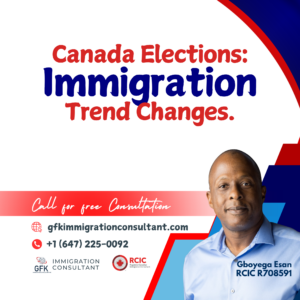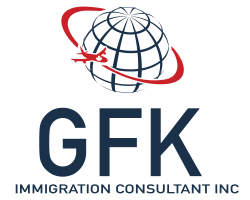
Canada Elections Immigration Trend Changes.
As Canada approaches its federal election on April 28, 2025, the political landscape is poised to influence one of the nation’s most critical policy areas: immigration.
With a population of 41,528,680 as of January 1, 2025, and a recent quarterly growth of 0.2%, immigration remains a cornerstone of Canada’s economic and demographic strategy.
However, challenges such as housing shortages, healthcare capacity, and public service strain have intensified debates, making immigration a pivotal election issue.
This analysis explores the current immigration situation, the stances of major political parties on immigration, and the potential outcomes based on the election results, providing a detailed understanding for stakeholders, including prospective immigrants, policymakers, and the public.
Table of Contents
Current Immigration Situation in Canada
Canada has been welcoming immigrants to boost its economy.
According to the latest Immigration Levels Plan for 2025-2027, announced on October 24, 2024, Canada aims to admit 395,000 permanent residents in 2025, followed by 380,000 in 2026, and 365,000 in 2027.
This number represents a reduction from previous targets, which had set a goal of 500,000 permanent residents for 2025, reflecting concerns about infrastructure capacity and sustainability.
The plan also includes controlled targets for temporary residents for the first time in history, such as international students and foreign workers, aiming to reduce their numbers to 5% of Canada’s population by the end of 2026.
Recent data shows a slight decline in the population of temporary residents, aligning with government efforts to manage migration levels.
According to official Statistics Canada released in March 2025, Canada’s temporary resident population has declined for the first time in three years, with a notable departure of about 28,341 temporary residents between October 1, 2024, and January 1, 2025.
This decline follows a period of rapid growth, with the temporary resident population increasing from 2.7 million at the start of 2024 to 3.02 million by January 1, 2025, as reported by INC News on March 20, 2025.
Their population was 3,020,936 as of January 1, 2025, making up 7.3% of the total.
The result represents a net loss of 28,341 people in the fourth quarter, a minor decline from 3,049,277 (7.4%) on October 1, 2024.
Recent policy changes, such as the 2024 Policy on Francophone Immigration, aim to increase French-speaking permanent resident targets outside Quebec to 10% by 2027, addressing demographic representation.
Major Political Parties and Their Immigration Stance
The election features four major parties with distinct immigration policies, each reflecting their ideological priorities.
Below is a detailed breakdown:
| Party | Leader | Stance on Immigration | Key Policies |
|---|---|---|---|
| Liberal Party | Mark Carney | Supports immigration but proposes capping levels for sustainability, focusing on integration | Cap immigration to align with housing and services; prioritize family reunification and economic growth |
| Conservative Party | Pierre Poilievre | Advocates reducing levels, focusing on economic migrants and border security | Reduce overall immigration further; prioritize skilled workers; enhance border controls |
| New Democratic Party (NDP) | Jagmeet Singh | Supports immigration, emphasizes efficiency, and compassion, particularly for families | Increase funding for processing; enhance settlement services; protect refugee rights |
| Green Party | Elizabeth May | Historically supports sustainable immigration, with a focus on environmental considerations | Promote green jobs through immigration; ensure alignment with climate goals; support refugee protection |
Liberal Party of Canada
Led by Prime Minister Mark Carney, who assumed office on March 14, 2025, following Justin Trudeau’s resignation, the Liberal Party has historically championed high immigration levels.
However, Carney has criticized recent policies for exceeding capacity, proposing a cap to return to pre-pandemic trends.
He claims his plan includes data-driven adjustments based on housing supply and public service capacity, aiming to integrate temporary residents into permanent status.
This aligns with the current reduction in permanent resident targets to 395,000 for 2025 and efforts to manage temporary resident numbers.
Conservative Party of Canada
Under Pierre Poilievre, the Conservative Party has positioned itself as a proponent of controlled immigration, emphasizing economic needs and border security.
Poilievre has stated intentions to cut immigration growth significantly, criticizing the Liberal government’s approach for straining infrastructure.
His criticism of increased immigration by the current government has led to a reduction in immigration targets by Liberals announced in October 2024.
However, Pierre claims that immigration needs to be reduced further, and once he said, “It will be much lower” in their tenure.
Policies include reducing overall levels, prioritizing economic streams like the Federal Skilled Worker Program, and enhancing border enforcement.
New Democratic Party (NDP)
The NDP, led by Jagmeet Singh, supports immigration to meet labour needs and uphold Canada’s humanitarian values.
They have criticized backlogs and delays, advocating for increased funding to reduce processing times and improve settlement services.
The party also pushes for family reunification priorities and protections for refugees, aligning with their commitment to fairness and dignity.
Green Party of Canada
Led by Elizabeth May, the Green Party’s historical stance supports immigration but emphasizes sustainability, particularly in the context of climate change and environmental impact.
While specific 2025 policies are not fully detailed, past platforms advocate for a fair system that supports green jobs and refugee protection, ensuring alignment with ecological goals.
Recent statements, such as calls for ambitious Francophone immigration targets, suggest continued support for cultural diversity.
Potential Election Outcomes and Their Impact on Immigration
The election outcome will shape Canada’s immigration trajectory, with each scenario presenting different implications:
1. Conservative Party Victory: Recent polls indicate the Conservatives are more likely to take over the reins, but are expected to win a minority government.
A Poilievre-led Conservative government would likely reduce immigration levels significantly, prioritizing economic migrants to address labour shortages while cutting back on family and humanitarian streams.
Such an outcome could lead to stricter border controls and potential reductions in false asylum claims.
2. Liberal Party Victory: If Mark Carney’s Liberals win, immigration levels are likely to be capped, focusing on sustainable growth and integration.
This could mean stricter controls on temporary residents, such as international students and foreign workers, with policies to ensure housing and healthcare capacity.
Family reunification and economic streams would remain priorities, but with a more measured approach, consistent with the current target of 395,000 permanent residents for 2025.
3. NDP Victory: An NDP government under Jagmeet Singh would likely maintain or increase immigration levels, focusing on efficiency and compassion.
Increased funding for processing and settlement services could reduce backlogs, while policies to support family reunification and refugee protection would strengthen Canada’s welcoming stance.
Coalition or Minority Government: Given the possibility of a minority government, as suggested by past election trends, coalition negotiations could lead to blended policies.
For instance, a Liberal-NDP coalition might result in higher immigration levels with improved processing, while a Conservative-led minority might face pressure to moderate cuts, potentially leading to compromises on economic and humanitarian streams.
The 2025 Canadian federal election is a critical juncture for immigration policy, with each party’s platform offering distinct visions for managing growth, integration, and sustainability.
The current reduction in permanent resident targets to 395,000 for 2025 and the recent slight decline in temporary resident populations highlight the government’s focus on balancing economic needs with infrastructure capacity.
As voters decide, the outcome will shape Canada’s ability to address pressing challenges like housing and healthcare while maintaining its reputation as a welcoming nation.
Canada Elections Immigration Trend Changes
GFK Immigration
Gboyega Esan RCIC R708591
Phone: +1 (647) 225-0092
#studyincanada #studyabroad #canada #studyinuk #studyinaustralia #ielts #studentvisa #studyinusa #studyvisa #immigration #canadavisa #visa #education #internationalstudents #overseaseducation #study #canadaimmigration #highereducation #studyoverseas #canadastudyvisa #immigrationconsultant #australia #university #workpermit #canadapr #expressentry #studyineurope #immigrationcanada
